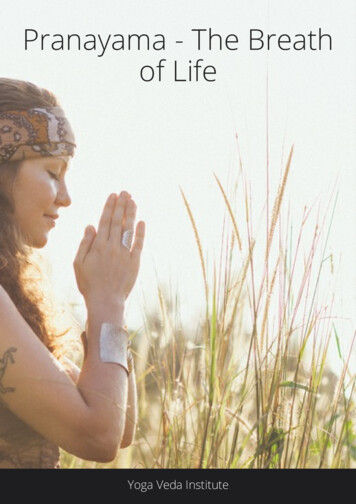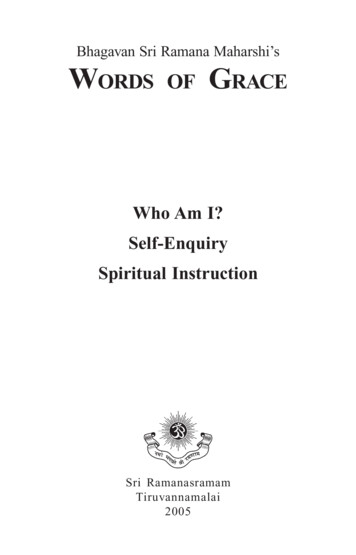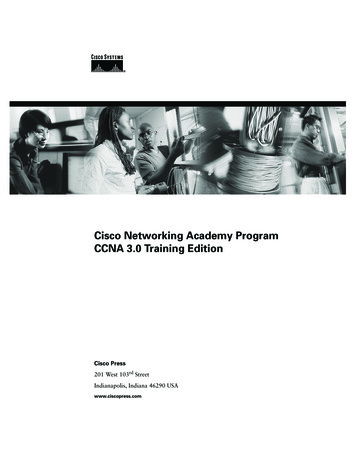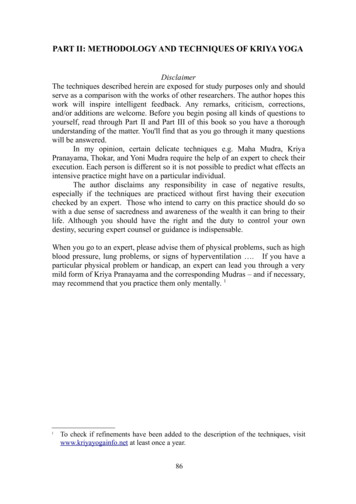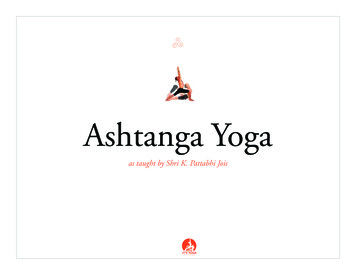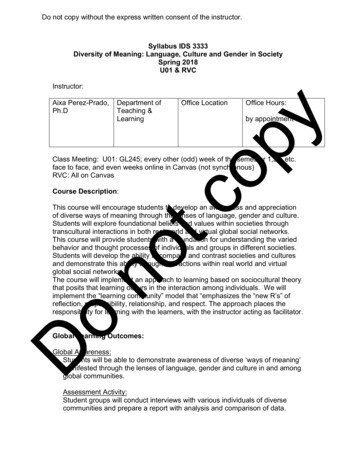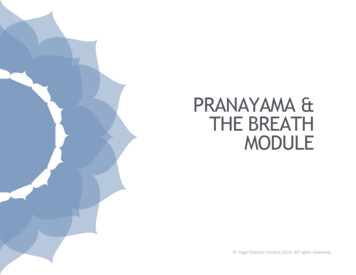
Transcription
PRANAYAMA &THE BREATHMODULE Yoga Teacher Central 2016. All rights reserved.1
PERSPECTIVES & CAUTIONSTERMINOLOGY & DEFINITIONSPranayama & The Breath ModuleCONTENTSBREATHING FUNDAMENTALSBASIC BREATH TRAINING & YOGICBREATHINGPRANAYAMA TECHNIQUES Yoga Teacher Central 2016. All rights reserved.
Chapter HighlightsINTRODUCTIONPRANAYAMATECHNIQUESKUMBHAKA CAUTIONUJJAYINADI SHODANAKAPALABHATITEACHING FORMAL PRANAYAMA.The ancient masters specifically developed the practiceIN-DEPTH COVERAGE OF UJJAYI,of pranayama to balance the emotions, clarify mentalNADI SHODANA AND KAPALABHATI.processes, and ultimately to integrate them into oneeffectively functioning whole.– Gary Kraftsow, Yoga for WellnessVersion 1.61 Yoga Teacher Central 2016. All rights reserved.
QUESTIONS ANSWERED HERE What are the fundamental benefits of pranayama? According to B.K.S. Iyengar, how does pranayama begin and end? Why is patience required for safe and effective pranayama practice? What is a fundamental caution against teaching pranayama? When practicing kumbhaka, what is important for safe practice? What is the meaning of the Sanksrit word, Ujjayi? While the sound of Ujjayi breath serves a purpose, it is not the essence of the practice.What aspect of the breath is Ujjayi designed to affect? What other benefits of Ujjayi? Provide instructions for teaching Ujjayi. What are the contraindications for Nadi Shodana? What is the primary purpose / benefit of Nadi Shodana? What does "Nadi Shodana" mean and how does this meaning relate to a furtherdescription of this practice? What is the corpus callosum? What is the result of increased activity across the corpus callosum? Describe instructions for hand placement, practice, and a variation of Nadi Shodana. What is the meaning of the Sanksrit word, Kapalabhati? What are the contraindications for Kapalabhati? Describe the purpose and benefits of Kapalabhati. Provide instructions for teaching Kapalabhati. Yoga Teacher Central 2016. All rights reserved.42
BREATH & BREATHINGFUNDAMENTALS PERSPECTIVESPhysical process of breathingImpact of breath on nervous systemFundamentals of natural breathingBASIC BREATH TRAINING &YOGIC BREATHINGThere are multiple angles from which toexamine the topic of pranayama andbreathing.While all are relevant and related, awarenessof the distinctions will assist you in organizingyour own study and in choosing teachings for Basic breath training, such as awarenessof the breathYogic Breathing to increase respiratoryefficiencyPRANA different situations. We offer expert teachings in each of thesePrana as life-force energy separate fromthe breath, and the relationship betweenPrana and breathEnergy concepts and subtle anatomyfrom yoga philosophyareas.PRANAYAMAThis Course covers topics related to teaching particular pranayamatechniques. See other Courses for additional topics.3Pranayama as one of the 8 Limbs and ayogic technique to access, stabilize,refine and direct pranaCautionsTechniques Yoga Teacher Central 2016. All rights reserved.
KEY POINTS Pranayama is said to balance the emotions and tobring mental clarity. According to B.K.S. Iyengar, pranayama beginswith an exhalation and ends with an inhalation. Progress in pranayama is a relatively slow andnon-linear process, requiring patience. Many experts advise that, with beginners, onlybreath practices are safe. Formal pranayamapractices are generally not recommended forbeginners.PRANAYAMAINTRODUCTION Particularly important is to avoidpracticing kumbhaka without knowledge andapplication of bandhas. See other Courses in Pranayama & The Breath forCautions, Breathing Fundamentals, Basic BreathPractices and more. Yoga Teacher Central 2016. All rights reserved. Yoga Teacher Central 2016. All rights reserved.4
EXPERT READINGSGO SLOWLY, GET TO KNOW YOUR BREATHINTIMATELY, EXPECT NON-LINEAR PROGRESSAlways keep your practice within comfortable limits.Remember that the breath should be tamed slowly. Stay witha particular breath, or an aspect of the breath, for a goodlong while. Get to know your breath intimately so that youlive with it moment to moment. Be willing, though, at times,to experiment, to go out on a limb and take a risk.Remember, too, that change in the breath comes slowly. AsBREATHE OUT TO BEGIN, INHALE TO ENDWesterners, we're committed to the idea of a linear kind ofAll stages of all pranayama begin with exhalation and endprogress as if our practice should move inexorably in awith inhalation. First, you must breathe out whatever tidalstraight line from point A to point B. That probably won'tair remains in the lungs, then start pranayama. Do not endhappen as you travel through the country of the Self—atit with exhalation, as this strains the heart, but take aleast that hasn't been my experience over the last eighteennormal inhalation at the end of each stage of pranayama.or so years. Things go smoothly for awhile, then come to aDo not use force.dead stop, start up all over again, then go straight downhill,all with no apparent logical explanation.– B.K.S. Iyengar, Light on Prãnãyãma– Richard Rosen, The Yoga of Breath5 Yoga Teacher Central 2016. All rights reserved.
KUMBHAKACAUTIONTeach breath retention only if qualified, andonly to experienced students. Spontaneous pauses may be part of an evolution ofpractice. Pranayama practices incorporatingkumbhaka, however, are known to be powerful whilealso presenting serious risk. Holding the breath is only recommended forexperienced students with qualified teachers. Most recommend kumbhaka only with awarenessof bandhas. "Like the formal Root and Upward Locks, outerretention (bahya kumbhaka) is a relatively advancedpractice best learned under the guidance of anexperienced teacher." (Richard Rosen)6 Yoga Teacher Central 2016. All rights reserved.
Deep breathing has nothing to do with pranayama and may bepracticed as an exercise for promoting health to any reasonable extent.Its beneficial effects depend chiefly upon the increased intake ofoxygen and a somewhat greater influx of prana into the body. As itdoes not affect the pranic currents in the body, its practice is notattended by any risks.IMPORTANTREADING ONKUMBHAKABreathing alternately through the two nostrils begins at once to affectthe pranic currents to a certain extent and tends to remove thecongestion from the channels in which prana flows normally. Thispurification of the nadis is a preparatory exercise and all those whointend to practice pranayama have to go through a long courseextending over several months or years. This exercise is not attendedwith any risk and can be adopted with caution by those who live awell-regulated and clean life and are not given to excesses of any kind.But since the pranic currents are affected in the process, caution andmoderation are necessary and it is advisable to work under thesupervision of an expert.Real pranayama begins when the breath is stopped for some timebetween inhalation and exhalation. The retention of breath, calledtechnically kumbhaka, affects the flow of pranic currents in a verymarked and fundamental manner. Pranayama has to be practiced fora long time, the period of kumbhaka being slowly increased over longperiods of time.The important point to keep in mind is this. Not onlyis kumbhaka the essential element of real pranayama but it is also thesource of danger in the practice of pranayama. The moment one startsretaining the breath—especially inside—in any abnormal manner, thedanger begins and one can never know what it will lead to, unlessthere is a practical and competent teacher at hand to guide andcorrect the flow of these forces if necessary.– I. K. Taimni, The Science of Yoga Yoga Teacher Central 2016. All rights reserved.7
EXPERTS AGREE SWAMI RAMASRI SWAMI SATCHIDANANDAAll aspirants are strictly advised not to practice the exercises ofkumbhaka (retention of breath) without applying the bandhas.Bandhas are locks, and there are three of them: jalandharabandha (chin lock), uddiyana bandha (abdominal lock) andmula bandha (root lock).One should be very careful about retention, however. It shouldbe practiced properly under personal guidance, without goingbeyond what a teacher tells us. The prana is very powerfulenergy. We shouldn't play with cobras without a proper cobratrainer nearby.– Swami Rama, Science of Breath– Sri Swami Satchidananda, The Yoga Sutras of PatanjaliB.K.S. IYENGARSEE ALSOKnowledge of the bandhas is essential for the properpractice of kumbhaka (breath retention). They act as safetyvalves for distributing, regulating and absorbing energy, and Breathing Fundamentals General Practice Cautions Specific cautions for each pranayama techniqueprevent its dissipation. An electric motor burns out itsvoltage if allowed to rise too high. Similarly, when the lungsare full and the energy in them is not checked by thebandhas, they will be damaged, nerves will be frayed andthe brain made unduly tense.– B.K.S Iyengar, Light on Prãnãyãma:278 Yoga Teacher Central 2016. All rights reserved.
UJJAYIUjjayi pranayama, also referred to as "thevictorious breath", provides the strengthrequired to master every asana. The absorbedprana (energy) can also be used to facilitatebody movement, allowing even Yogis with slightbuilds to seem able to defy gravity and glidethrough movements almost effortlessly. As thewaves form the beach, so too does the breathform the Ashtanga Yoga practice. Your innerwaves set the rhythm. The murmuring of yourbreath becomes the murmuring of your innerocean while waves of inhalation flood yourinner coast. Like a surfer who rides the wavesof a real ocean, your inner surf carries you fromasana to asana. Your breath directs eachmovement.OVERVIEW Ujjayi is the process of narrowing the passageway throughwhich air is moving, allowing the breath to be drawn out andconsciously controlled. The practice causes an "ocean wave" or "hissing" sound. Although this breath is done with the nostrils, it can be easierto learn with an open mouth. Yoga Teacher Central 2016. All rights reserved.– ashtangayoga.info9
UJJAYI PURPOSE& BENEFITSUjjayi is a technique with such powerful benefits that it should be accessible toeveryone. It is an essential tool that you will find yourself using in every aspect ofyour life. People from my classes are always writing, calling, or coming up to meto comment on the effectiveness of the breathing method and how it has helped Heatingthem to raise mindfulness, birth babies, diminish stress, and appreciate life morefully. Slow breath– Beryl Bender Birch, Power Yoga Helps practitioner learn to lengthen and directthe breathThe friction of the air passing through the lungs and throat generates internalbody heat. It is similar to a massage for the internal organs; as the core becomes Diminish stress, “calms nerves”warm from the inside, the body becomes prepared for the asana practice. Said to remove phlegm and cleanse lungs.– Lisa Mitchell, MindBodyGreen, 8 Reasons Why We Use Ujjayi Breath Support steadiness, endurance and focus.It is said that Yogis can melt snow by using Ujjayi breathing. You might feel heatwhen first applying this technique. As your practice advances the energy will When done in a supported position, is said tobecome more subtle. A quiet but steady force will develop deep inside you withrelieve symptoms of high blood pressure.which you will be able to master virtually impossible physical challenges withease. Superficially, the muscles carry the Yogi through the air. However it is the “Enhance ventilation of lungs” (Swami Rama)breath which provides the necessary prana (energy). “Fill the whole body with vitality” (Swami Rama)– ashtangayoga.info, Ujjayi Pranayama – The Victorious Breath10 Yoga Teacher Central 2016. All rights reserved.
UJJAYI: GOING DEEPER Ujjayi is often used as the primary breathing practice duringasana in Ashtanga, Power, Vinyasa & other styles of yoga.LESS ABOUT THE SOUND; MORE ABOUT CONSISTENCY INTHE BREATH This pranayama may be maintained throughout much ofpractice and, according to B.K.S. Iyengar, is "the onlyThe real essence of ujjayi is not so much the sound that we are making(for ujjayi can be done without any sound) but in the type and quality ofthe breath that we are making. What we are really after is consistencyin the breath: evenness and rhythm. If you look at how people breatheduring the course of the day, you will notice a profound lack ofevenness; the breath is fast one moment and slow the next, deep hereand shallow there The most basic key to good health and happiness, asthe yogis see it, is an evenness in the prana and life-force pranayama which can be done at all times of the day andnight." Other experts, however, do not recommend Ujjayi bepracticed in all cases. The sound of Ujjayi is often used as the focal point ofconcentration for directing and controlling the mind.The most effective thing we can do is stabilize our breathing as often aswe can and for as long as possible. The way we establish this pattern ispracticing ujjayi breathing for the entire length of our practice. In thisway, we create awareness of our breath and our prana and consciouslyattempt to smooth and stabilize our energetic patterns. It is actually themost essential aspect of the yoga practice, regardless of which posturesor style or system we work with, for breath and prana are our mostessential functions. Because Ujjayi has to be created over and over again, a lack offocus on breath can indicate the mind has wandered. The sound can make it easier to identify when the breath hasbecome erratic. This can give the student awareness and anopportunity to reduce effort, release tension, re-focus on thebreath or whatever practice helps to effectively regain– Randall O'Leary, YogiTimes, Ujjayi Breathing27steadiness.11 Yoga Teacher Central 2016. All rights reserved.
UJJAYI: SANSKRITThe prefix “ud” means upwards orexpanding. It also conveys the sense ofpreeminence and power. “Jaya” meansconquest or success, and, from anotherpoint of view, restraintUjjayi means 'to win,' 'to conquer,' 'to– Light on Prãnãyãmaacquire by conquest,' 'to be victorious.'The name is partly suggested, it seems,by the way the aspirant swells her chestJaya means victory. Ujjayi meansout like a proud conqueror, in order tovictorious or conquering. It is so calledmaximize the capacity of her lungs.because the technique allows us toHidden in this word is the little prefixbecome victorious inud, which means 'up,' in the sense ofpranayama. Pranayama meanssuperiority in place, rank, or power.extension or stretching of prana, and thisThis also suggest that ujjayi is ais exactly what Ujjayi does.superior or powerful technique for– Pranayama The Breath of Yogaliberation, a tool by which the yogiscan conquer the forces of ignoranceSome say the name of Victory orand bondage.Victorious is because the practice helps– Richard Rosen, The Yoga ofthe mind to rise victoriously above itsBreathusually restless nature. Yoga Teacher Central 2016. All rights reserved.12
UJJAYI LIMITATIONSUjjayi breathing is only pranayama in a preparatory sense. Pranayama is formal sitting practice involving a variety ofcounted kumbhakas. so Ujjayi during one's asana practice is not a replacement for formal sitting kumbhaka practicebut preparation for it. Ujjayi without kumbhaka cannot by itself bring about the balance of ida and pingala, which isobtained through nadi shodhana pranayama, nor can it bring about the complete cessation of fluctuations of prana,which is obtained through extensive breath retentions.– Gregor Maehle, Pranayama The Breath of Yoga.13 Yoga Teacher Central 2016. All rights reserved.
UJJAYI INSTRUCTIONSWhen introducing the practice to beginners, you may wish to first teach the practice using an open mouth.Open mouth and exhale slowly.Softly whisper "hhhaaa."Notice that the sound is like listening to the ocean in a shell."Feel the air swirl in the back of the throat." (David Swenson)Inhale through the nose, making the same sound on inhale.Repeat and then eventually, close mouth, continuing to make sound. David Swenson recommends closingmouth midway through exhale, letting air continue exiting through nose instead of mouth.Don't sniff; rather, keep nostrils relaxed.14 Yoga Teacher Central 2016. All rights reserved.
MORE ON UJJAYIIn this technique the valve is established by a partialcontraction of the glottis. This contraction is used duringinhale and exhale. The sound of the vibration at thethroat can be so subtle as to be inaudible even to thepractitioner or loud enough to be heard by othersnearby. The heating effect is intensified as the sound atIt should emerge from the upper part of yourthe throat becomes louder.throat and not from the upper or front part of yournose Because of the resistance of air in your throat,– Gary Kraftsow, Yoga for Transformationyou will find this sound automatically beingAs you breathe in, your body, lungs, brain, andcreated. Stretch your inhale and the exhale as muchconsciousness should be receptive rather than active.as you can without generating tension anywhere inBreath is received as a divine gift and should not beyour body, and let the sound of the breath bedrawn in forcefully.smooth and unbroken.– yogawiz.com– B.K.S. Iyengar, Light on PranayamaIt is helpful to gently smile while breathing to allowThe sound is quite similar to that of a wave washing upthe air to swirl around the back of the throat beforeon the shore and then washing back down again. Makecontinuing its journey to the lungs. This swirlingsure that the sound is even, calming and gentle. If youaction is what creates the unique sound which hasstrain, you will trigger the sympathetic nervous systembeen described as wind in the trees, a distantand the method will not achieve its aim.ocean, a cobra snake or, for the less poetic, Darth– Gregor Maehle, Pranayama The Breath of YogaVader from Star Wars.– David Swenson, Ashtanga Yoga Yoga Teacher Central 2016. All rights reserved.15
OVERVIEWNADI SHODANANadi Shodana is also known as Anuloma Viloma.16 Yoga Teacher Central 2016. All rights reserved.
PURPOSE & BENEFITSThe most powerful method of balancing idaand pingala is Nadi Shodhana, alternate-NADISHODANAnostril breathing. (Literally, the Sanskritmeans “nadi cleansing.”) This practice iseffective because the ida nadi is directlyconnected to the left nostril, and the pingalanadi to the right. A few rounds of this basicpranayama technique at the end of an asana Balances brain's hemispherespractice are an excellent way to help restoreequilibrium between the two nadis and to Invites a still, clear mind; brings mental claritycompensate for any imbalance you mayhave inadvertently caused during your Relaxingpractice. Steadies energy– James Bailey, Yoga Journal, Discover theIda and Pingala Nadis "Can help calm you down" (Jennifer Nelson, YogaJournal, Balance Builders) Yoga Teacher Central 2016. All rights reserved.17
NADI SHODANA:BACKGROUND The brain's right and left hemispheres are connected by the corpuscallosum—a conduit or bridge between the sides. The left brain controls the right side of the body and the right brain controlsthe left. Typically we shift between left and right brain dominance throughout the day,CAUTIONSapproximately every 90 minutes. This correlates with one nostril breathingfreely while the other is partially constricted. Contraindications: none noted. According to which half of the brain is dominant, a person's energy, state ofmind and mood are impacted. In addition, hemispheric dominance is One of the safest pranayamaassociated with particular types of activity such as logical thinking (left brain)practices to offer all levels ofor innovation (right brain).students but please see Cautions for Inter-hemispheric transfer of information between the left and right brains ismore information aboutaccomplished via increased activity across the corpus callosum, resulting in aavoiding pranayama with rawshift from hemispheric dominance to synchronization and harmony in thebeginners.brain. The corpus callosum can be strengthened to become more capable oftransmitting information between hemispheres. Albert Einstein and the famed psychic healer Edgar Cayce were said to haveunusually large corpous callosum.18 Yoga Teacher Central 2016. All rights reserved.
NADI SHODANA INSTRUCTIONSTraditionally, the thumb and ring finger are usedThe following instructions are for a simple common formto block nostrils. Instructions for this:of Nadi Shodana. This version has no breath retention.Place the peace fingers of your right handTake a complete cycle of breath through bothlightly onto your forehead. (Or, an alternatenostrils and empty the breath on the exhale.option is to take Vishnu Mudra with the rightGently block right nostril. Inhale through left.hand by bringing the peace fingers to thecenter of the palm.Gently block left. Exhale right. Inhale right.Let ring finger gently rest over left nostriland thumb over the right.Gently block right. Exhale left. Inhale left.The index and middle fingers rest betweenContinue, alternating nostrils with each exhalation.the eyebrows and pinky hooks over ringfinger.Breathe smoothly and steadily. Remain relaxed andcalm. Practice up to 5 minutes.Some don't teach the traditional hand placementand simply instruct students to block theirnostrils. Yoga Teacher Central 2016. All rights reserved.19
VARIATIONSThere are many variations.Inhale through both nostrils.Here is one variation that RodAt the top of the inhale, block one side. ExhaleStryker teaches on histhrough the other.Meditations for Life CD.Inhale through both.The added simplicity of thisExhale through opposite side.variation can be helpful withbeginners or when there is littleInhale through both.time.Continue. Yoga Teacher Central 2016. All rights reserved.20
ADDINGAFFIRMATIONSAffirmations can be an added component to breathpractices. The following example is from Nischala Joy Devi.INHALE“The strength I feel inside me is enough to sustainme during any experience I have today.”EXHALE“The compassion from my heart will lead me tohelp anyone in need.”With such thoughts, what we’re doing is strengthening andbringing prana into our system, which helps us becomestrong and compassionate with others.– Nischala Joy Devi, Yoga Journal, Balance Builders Yoga Teacher Central 2016. All rights reserved.21
KAPALABHATIOVERVIEW While often referred to as pranayama, at other times Kapalabhati ismore technically referred to as a cleansing practice. The translation is "Skull Shining" breath. While some refer to it as the"Breath of Fire," the Kundalini Breath of Fire is usually considered adifferent practice. Kapalabhati breathing is often taught at the beginning of class tobring warmth & energy and during asanas for connecting with thecore. Yoga Teacher Central 2016. All rights reserved.22
Cleanses nasal passagesSaid to "cleanse the energy body" of excess stagnationIncreases alertnessDecreases lethargySaid to "purify" nervesKAPALABHATI:PURPOSE &BENEFITSDecreases carbon dioxideTones abdominalsMay find breath to be smoother and/or longer afterward andmind to feel more spaciousWhile some sources cite the practice as "increasing oxygenabsorption,“ in The Science of Yoga, William Broad asserts thatmost yogic breathing does not actually do this. We mention ithere so that you can investigate the different perspectives if youwish.23 Yoga Teacher Central 2016. All rights reserved.
After eatingPregnancyMenstruationHeart conditionsHigh blood pressureKAPALABHATI:CONTRAINDICATIONSEye or ear issuesHerniated discSee General Cautions for more information.24 Yoga Teacher Central 2016. All rights reserved.
KAPALABHATI INSTRUCTIONSTake slow, deep and steady breaths through nostrils.Prepare by drawing abdomen in on exhalation for a few rounds.When moving into Kapalabhati breathing, let belly release as inhalation arises spontaneously.Continue by speeding up exhalations, accomplished by drawing abdomen in and continuing to let bellyrelease with inhalation.Keep upper body and face relaxed.In contrast to a natural breath, the exhalation is active and the inhalation passive; simply receive the breathon inhalation.Practice up to a minute and then breathe normally before beginning another round; practice up to 3 rounds.Experienced practitioners may wish to move to single nostril version. Breathe only through right nostril for2 to 3 rounds; then breathe only through left nostril for 2 to 3 rounds; complete by practicing Kapalabhatithrough both nostrils for 2 to 3 rounds. Yoga Teacher Central 2016. All rights reserved.25
RELATEDTECHNIQUE:BHASTRIKA Related to Kapalabhati is Bhastrika, or BellowsBreath, which has similar purpose and benefits. This technique is more advanced, however, and ismore vigorous as it requires a forceful inhale andexhale. See more here. Yoga Teacher Central 2016. All rights reserved.2628
ENDPRANAYAMATECHNIQUES29 Yoga Teacher Central 2016. All rights reserved.
Many experts advise that, with beginners, only breath practices are safe. Formal pranayama practices are generally not recommended for beginners. Particularly important is to avoid practicing kumbhaka without knowledge and application of bandhas. See other Courses in Pranayama & T
